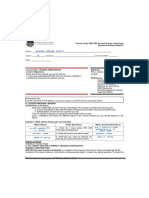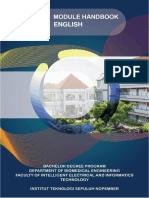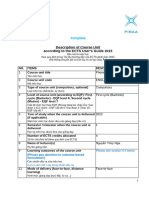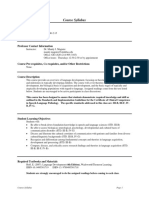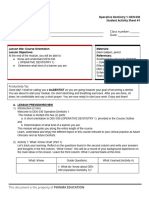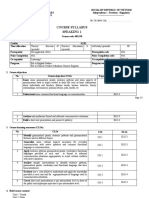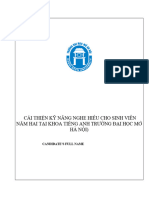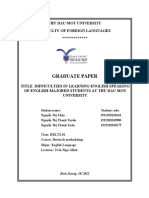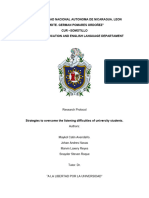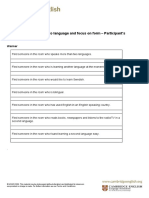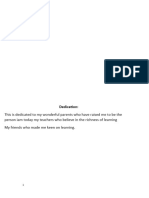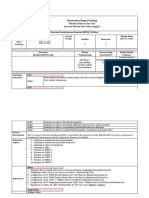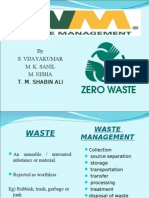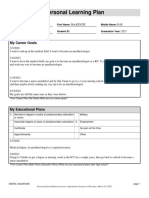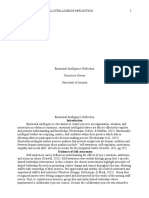This Document Is The Property of PHINMA EDUCATION
This Document Is The Property of PHINMA EDUCATION
Uploaded by
rior.insisto.swuCopyright:
Available Formats
This Document Is The Property of PHINMA EDUCATION
This Document Is The Property of PHINMA EDUCATION
Uploaded by
rior.insisto.swuOriginal Title
Copyright
Available Formats
Share this document
Did you find this document useful?
Is this content inappropriate?
Copyright:
Available Formats
This Document Is The Property of PHINMA EDUCATION
This Document Is The Property of PHINMA EDUCATION
Uploaded by
rior.insisto.swuCopyright:
Available Formats
DEN 020: Oral Histology and Embryology Laboratory
Student Activity Sheet #1
LESSON TITLE: DEN 020 Laboratory (COURSE ORIENTATION) MATERIALS:
Ballpens, erasers, pencils and
LESSON OBJECTIVES: module
At the end of the module, you will be able to:
1. Know and understand DM 020 (Laboratory). REFERENCES:
2. Determine what kind of a learner you are. Southwestern University
PHINMA – College of
Dentistry Curriculum
Effective SY 2018-2019.
PRODUCTIVITY TIP:
Good day! You are about to start your module. Do short stretching and breathing exercises. After you are
done, sit down, be comfortable and say a short prayer. You are now ready to start your work. Enjoy and learn!
A. LESSON PREVIEW / REVIEW
Introduction (2 minutes)
Welcome to DEN 020 (Oral Histology and Embryology)! The module is divided into two (2) parts: a. A short
orientation to DM 020 (Oral Histology and Embryology) provided in the Course Outline and b. Determination of
what kind of a learner you are. This will module will guide you along the entire length of the course. Learn,
understand and enjoy the different topics in this course relevant to your dental practice in the future.
Activity 1: What I Know Chart, part 1 (3 minutes)
What I Know Guide Questions: What I Learned (Activity 4)
It tackle about oral structure 1. What do I know about DM 020 (Oral I needed to learn a lot of
Histology and Embryology)? lessons with this subject
Kinesthetic 2. What do I think is my learner type? Kinesthetic
I needed to try comprehend the 3. What tips do I have to improve my Just read and comprehend it
topic and read it with learning as a particular learner type? properly
undertanding
B. MAIN LESSON
This document is the property of PHINMA EDUCATION
DEN 020: Oral Histology and Embryology Laboratory
Student Activity Sheet #1
Name: Class number:
Section: Schedule: Date:
Activity 2: Content Notes (13 minutes)
The Course Outline:
PEN Code: DEN 020 Credit: 4
PEN Subject Title: Oral Histology and Prerequisites: HES 096 (General Histology and
Embryology (Laboratory) Embryology) and DEN 017 (Oral Anatomy)
Subject Description:
Oral microscopic anatomy and embryology involves the study of the microscopic features of the tissues of the
oral cavity with emphasis on the microscopic structures of the teeth and their supporting tissues.
Objectives:
At the end of the course, you should be able to:
1. Set course expectations, known requirements and house rules.
2. Identified and understood the microscopic details of the tissues of the oral cavity.
3. Differentiated the various tissues that make up and support the teeth with regards to their physical, chemical
and structural characteristics.
4. Related the significance of these microscopic structures to clinical dentistry.
5. Utilized the learned knowledge on the development of the face, teeth and jaws in creating a structural analysis
on the recognition of abnormalities that are developmental in nature.
Grading Period Topics/Activities Schedule
Orientation
1st Day of Class Module 1: Course Orientation
Module 2: Introduction to Oral Histology and
Embryology
Module 3: The Compound Light Microscope
1st Periodic Grading Module 4: The Cell
Period (P1) Module 5: Regions of the Face and Neck
Module 6: The Para-oral and Dental Tissues
Module 7: Development of the Human Face
Module 8: Development of the Tongue
st
1 Periodical Exam (P1 Exam)
Module 9: Tooth Crown Development
Module 10: Tooth Root Development
Module 11: Enamel
2nd Periodic Grading
Module 12: Dentin
Period (P2)
Module 13: Pulp
Module 14: Cementum
Module 15: Periodontal Ligament
2nd Periodical Exam (P2 Exam)
Module 16: Alveolar Process
Module 17: Oral Mucosa
3rd Periodic Grading Module 18: Salivary Glands
Period (P3) Module 19: Paranasal Sinuses
Module 20: Temporomandibular Joint
Module 21: My DEN 020 Evaluation
This document is the property of PHINMA EDUCATION
DEN 020: Oral Histology and Embryology Laboratory
Student Activity Sheet #1
Name: Class number:
Section: Schedule: Date:
3rd Periodical Exam (P3 Exam)
The duration of this course is for one (1) semester. The course is divided into three (3) appropriate grading
periods with periodical exams after each. Time schedules are provided for each grading periods and
periodical exams and these should be strictly followed.
Each of the topics are assigned to the three (3) grading periods and are in modular form to guide you as
you study the course.
You have to accomplish the modules that are specified per grading period as they will be checked later
and the periodical exams will be based from them.
Each module is carefully designed to be concise but knowledge packed from sources which you will not
need to get hold on to while at home in whatever circumstances you are in even without an internet
connection or a library nearby. They are also designed in such a way that if a face to face instruction will
not be feasible, they can be done in the luxury of your home.
Should there be any inquiries about each of the modules or any academic concerns, I can be contacted
through the following means available for you:
Email address: mvdigamon@swu.edu.ph
Facebook Messenger: Doc Marie Digamon
References:
Berkovitz, B. K. B., Holland, G. R. and Moxham, B. J. 2009. Oral Anatomy, Histology and Embryology. 4 th Edition.
USA: Mosby Elsevier.
Dudek, R. W. 2001. High-Yield Embryology. 2nd Edition. USA: Lippincott Williams & Wilkins.
Fehrenbach, M. J. and Popowics, T. 2015. Illustrated Dental Embryology, Histology and Anatomy. USA: W B
Saunders Company.
Lo, R. W. et al. 2015. Basic Histopathologic Techniques. Philippines: C & E Publishing, Inc.
Nanci, A. 2019. Ten Cate’s Oral Histology: Development, Structure and Function. 9th Edition. USA: Mosby
Elsevier. (Main Textbook)
Contact Information:
MARIEGAIL V. DIGAMON, DMD
Associate Professor
RODIVICK O. DOCOR, DMD, MA, PhD
Dean
This document is the property of PHINMA EDUCATION
DEN 020: Oral Histology and Embryology Laboratory
Student Activity Sheet #1
Name: Class number:
Section: Schedule: Date:
B. What kind of a Learner I am:
Everyone processes and learns new information in different ways. There are three main cognitive learning styles:
visual, auditory, and kinesthetic. The common characteristics of each learning style listed below can help you
understand how you learn and what methods of learning best fits you. Understanding how you learn can help
maximize time you spend studying by incorporating different techniques to custom fit various subjects, concepts,
and learning objectives. Each preferred learning style has methods that fit the different ways an individual may
learn best.
VISUAL LEARNER
• Uses visual objects such as graphs, charts, pictures, and seeing information.
• Can read body language well and has a good perception of aesthetics.
• Able to memorize and recall various information.
• Tends to remember things that are written down.
• Learns better in lectures by watching them.
AUDITORY LEARNER
• Retains information through hearing and speaking.
• Often prefers to be told how to do things and then summarizes the main points out loud to help with
memorization.
• Notices different aspects of speaking.
• Often has talents in music and may concentrate better with soft music playing in the background.
KINESTHETIC LEARNER
• Likes to use the hands-on approach to learn new material.
• Is generally good in math and science.
• Would rather demonstrate how to do something rather than verbally explain it.
• Usually prefers group work more than others.
Cuyamaca College. (2003). Visual learning. Retrieved May 28, 2020, from:
http://www.cuyamaca.edu/eops/DSPS/resourcesvis.asp
Landsberger, J. (n.d.). Study guides and strategies: Visual/spatial learning. Retrieved May 28, 2020, from:
http://www.studygs.net/visual.htm
Wong, L. (2006). Essential study skills (5th ed.). Boston, MA: Houghton Mifflin.
http://blc.new.uc.iupui.edu/academic-enrichment/study-skills/learning-styles/3-learning-styles
Activity 3: Skill-building Activities (with answer key) (18 minutes + 2 minutes checking)
Answer the questionnaire on ways of learning found below adapted from the DED (Deutscher
Entwicklungsdienst) Learner Type Test (2004). Fill out the number of points to corresponding way of learning.
Add the numbers you entered in the boxes. The way of learning with the highest total points will best describe
your learner type. Good Luck and Enjoy!
INSTRUCTIONS: Below are different ways of learning. To each statement, write the number of point/s in the
box on the right corresponding to how much you remember using this particular way of learning:
This document is the property of PHINMA EDUCATION
DEN 020: Oral Histology and Embryology Laboratory
Student Activity Sheet #1
Name: Class number:
Section: Schedule: Date:
Write 3 points when you remember most by using this way of learning.
Write 2 points when you remember a number of things by using this way of learning.
Write 1 point when you remember least by using this way of learning.
Letter WAYS OF LEARNING Points
A Prepare a chart when working with factual data. 3
B Lecture to a lecture on a specific topic. 2
In Biology, collect various plants, dry them, stick them in a folder and write short 2
C explanations.
D View a cartoon (with no comments) about smoking. 2
E Listen to someone reading text from a book. 2
F Look at pictures and drawings from a textbook. 2
G Prepare a drawing to cover a learning unit. 2
H Listen to English language from an audio book. 2
I Lecturer shows powerpoint slides concerning a topic. 1
J Someone explains how a President is elected. 3
K Write new terms learned onto a notepad. 2
L View issues at an exhibition. 2
M Read a topic from a notebook. 2
N Someone reports results after working in a group. 2
O Conduct a simple experiment during a seminar. 2
P Listen to a debate over the radio on an actual topic. 2
Q Looking at a picture book about daily life in Germany. 2
R Write down the most important information of a topic. 3
I AM THIS TYPE OF LEARNER…
INSTRUCTIONS: Write the points you assigned to each lettered way of learning below it. The type of learner
with the highest total number of points best describes you.
LEARNER TYPE WAYS OF LEARNING TOTAL POINTS
VISUAL LEARNER D + F+ I + L + M + Q 11
AUDITORY LEARNER B+E+H+J+N+P 12
KINESTHETIC LEARNER A+C+G+K+O+R 15
Activity 4: What I Know Chart, part 2 (2 minutes)
Go back to the “What I Know Chart” in Activity 1 and answer the “What I Learned” column.
Activity 5: Check for Understanding (5 minutes)
Surprise! Please check the type of learner you are and understand the tips to improve your learning style.
If you are a combination of 2 dominant learner types then you have the ability to be flexible between
those types depending on the need of the situation.
This document is the property of PHINMA EDUCATION
DEN 020: Oral Histology and Embryology Laboratory
Student Activity Sheet #1
Name: Class number:
Section: Schedule: Date:
I am a Tips for Kinesthetic Learner
KINESTHETIC • Take study breaks often
LEARNER • Learn new material while doing something active (e.g., read a textbook while on a
treadmill)
• Chew gum while studying
/ • Work while standing
• Try to take classes with instructors who encourage demonstrations and fieldwork
Cuyamaca College. (2003). Visual learning. Retrieved May 28, 2020, from:
http://www.cuyamaca.edu/eops/DSPS/resourcesvis.asp
Landsberger, J. (n.d.). Study guides and strategies: Visual/spatial learning. Retrieved May 28, 2020, from:
http://www.studygs.net/visual.htm
Wong, L. (2006). Essential study skills (5th ed.). Boston, MA: Houghton Mifflin.
http://blc.new.uc.iupui.edu/academic-enrichment/study-skills/learning-styles/3-learning-styles
C. LESSON WRAP-UP
Activity 6: Thinking about Learning (5 minutes)
Work Tracker
You are done with this session! Let’s track your progress. Shade the session number you just completed.
Think about your Learning:
Please answer the following questions:
This document is the property of PHINMA EDUCATION
DEN 020: Oral Histology and Embryology Laboratory
Student Activity Sheet #1
Name: Class number:
Section: Schedule: Date:
Please rate your activity today by placing a check mark (/) before a choice. Please explain your choice on the
blank space beside the table:
1. Boring
2. Not informative
3. Challenging
4. Fair
5. Fun
“What details in the content and/or activities were not clear to you?”
None so far
D. FREQUENTLY ASKED QUESTIONS:
I know my learner type however, I find it difficult to concentrate on a given task.
Can you recommend a technique on how to improve it?
Based on my experience, I do the “Pomodoro Technique”. Pomodoro means 'tomato'. The
technique is the creation of Francesco Cirillo who initially used a tomato-shaped kitchen timer
to time his 25 minute work periods. He explains that the action of twisting the timer and the
mechanical 'clicks' as it slowly revolves are helpful to boost focus (Cirillo, 2012).
It is a method of time management that encourages us to focus for 25 minute work or task, each followed by a
shorter break of 5 minutes or so.
Why 25 minutes work or task?
The exact time can depend on the individual. Each of us has a different attention span but 25
minutes is brief enough that most people can keep up concentration even on a dull or repetitive
task, especially with the prospect of an imminent break.
Why such short breaks?
A 3 to 5 minute break is considered ideal, because it gives your eyes and mind a rest, but avoids
stopping for so long that you lose track of what you are doing. Suitable break activities could
include going for a short walk outside, getting yourself a drink, doing some press-ups or playing
a tune on a musical instrument. However don't worry after four pomodoros, you are advised to
take a longer break of 20-30 minutes. So you will get your lunch or dinner.
Reference
Cirillo, F. 2007. The Pomodoro Technique (The Pomodoro). Retrieved May 27, 2020 from
http://baomee.info/pdf/technique/1.pdf.
This document is the property of PHINMA EDUCATION
You might also like
- Practical Research 1: Quarter 4 - Module 1: Qualitative Research DesignDocument23 pagesPractical Research 1: Quarter 4 - Module 1: Qualitative Research DesignAster Jade80% (5)
- How to Reach the 9.0 in IELTS Academic ListeningFrom EverandHow to Reach the 9.0 in IELTS Academic ListeningRating: 4.5 out of 5 stars4.5/5 (7)
- Regulation No. 5 of 2015 Indonesia Location PermitDocument24 pagesRegulation No. 5 of 2015 Indonesia Location PermitWishnu BasukiNo ratings yet
- Lesson Plan - Genograms Focusing and Empathic ConfrontationDocument5 pagesLesson Plan - Genograms Focusing and Empathic Confrontationapi-246356859No ratings yet
- Phoenix Black-Microwave Muffle FurnaceDocument12 pagesPhoenix Black-Microwave Muffle FurnaceMARCOS ALEJANDRO CHAMORRO TRUJILLONo ratings yet
- Test Bank Gridner and Escott-Stump: Nutritional Foundations and Clinical Application: A Nursing Approach, 6th Edition Chapter 5 FatsDocument10 pagesTest Bank Gridner and Escott-Stump: Nutritional Foundations and Clinical Application: A Nursing Approach, 6th Edition Chapter 5 FatsIzzie JeanNo ratings yet
- He - Commercial Cooking CGDocument3 pagesHe - Commercial Cooking CGEdlyn Faith Robles Padilla100% (4)
- Propedeutics of Masticatory Organ Diseases With Elements of Dental ProphylaxisDocument5 pagesPropedeutics of Masticatory Organ Diseases With Elements of Dental ProphylaxisBear AbigNo ratings yet
- Silabo Ingles 2020-IiDocument11 pagesSilabo Ingles 2020-IiEmerson Eusebio Quispe PonceNo ratings yet
- Garcia Teeth UnitDocument16 pagesGarcia Teeth Unitapi-282227487No ratings yet
- CT Sas 1Document7 pagesCT Sas 1ph28xhhcxsNo ratings yet
- GROUP 6 Research Proposal FinalDocument23 pagesGROUP 6 Research Proposal Finalnduyanh591No ratings yet
- ESP AssignmentDocument15 pagesESP AssignmentPhúc Đoàn0% (2)
- IN ENG Module Handbook - UG184914 - EnglishDocument20 pagesIN ENG Module Handbook - UG184914 - EnglishNina ApriskaNo ratings yet
- Portfolio: Tecnica Del Norte University The Academic Language CenterDocument54 pagesPortfolio: Tecnica Del Norte University The Academic Language CenterAnia CuasapudNo ratings yet
- Syllabus Virtual English IDocument9 pagesSyllabus Virtual English ILORENA VELOZNo ratings yet
- Phonetics - Phonology0805Document11 pagesPhonetics - Phonology0805nguyenhung2610004No ratings yet
- PlanDocument9 pagesPlansabamunir241997No ratings yet
- UT Dallas Syllabus For Comd6307.001.09s Taught by Mandy Maguire (mjm053000)Document7 pagesUT Dallas Syllabus For Comd6307.001.09s Taught by Mandy Maguire (mjm053000)UT Dallas Provost's Technology GroupNo ratings yet
- BMHA121 Course Module 1Document4 pagesBMHA121 Course Module 1kasonde bowaNo ratings yet
- Ms Dung Research Proposal 4Document15 pagesMs Dung Research Proposal 4Đào Nguyễn Duy TùngNo ratings yet
- Sas #1 - Den030Document9 pagesSas #1 - Den030Donna Jayne AlianzaNo ratings yet
- M06 - Course Syllabus - 001130 - Speaking 1Document15 pagesM06 - Course Syllabus - 001130 - Speaking 1Panda NguyễnNo ratings yet
- 5th Year Pediatric Dentistry CourseDocument7 pages5th Year Pediatric Dentistry CoursecareNo ratings yet
- Zonyra PerfectDocument32 pagesZonyra PerfectNanaba Kay BeeNo ratings yet
- Practical Research 1 - Quarter 1 - Module 3 of 4 - Identifying The Inquiry and Stating The Probem (Week 5 To Week 6) - v2Document13 pagesPractical Research 1 - Quarter 1 - Module 3 of 4 - Identifying The Inquiry and Stating The Probem (Week 5 To Week 6) - v2loraine.ruadoNo ratings yet
- Modul TEFLDocument146 pagesModul TEFLBestieNo ratings yet
- Project English PRUEADocument12 pagesProject English PRUEAsofy rodriguezZNo ratings yet
- S2 Q2 PR1 Week1Document20 pagesS2 Q2 PR1 Week1Jihyun KimNo ratings yet
- Cao Ngọc Khánh-22A7101D0160-2271A11_2Document17 pagesCao Ngọc Khánh-22A7101D0160-2271A11_2shiroayame4451No ratings yet
- Difficulties of English Majored Students in Speaking English at Thu Dau Mot UniversityDocument17 pagesDifficulties of English Majored Students in Speaking English at Thu Dau Mot UniversityTuyền NguyễnNo ratings yet
- Final Ktdc 2Document24 pagesFinal Ktdc 2hoangkhanhlinh4903No ratings yet
- ENG101.46spa.3 LTDocument15 pagesENG101.46spa.3 LTLưu Quang HiếuNo ratings yet
- UT Dallas Syllabus For Spau3303.001.08f Taught by Mandy Maguire (mjm053000)Document6 pagesUT Dallas Syllabus For Spau3303.001.08f Taught by Mandy Maguire (mjm053000)UT Dallas Provost's Technology GroupNo ratings yet
- Protocol Listening Difficulties.Document11 pagesProtocol Listening Difficulties.Edwing ArtolaNo ratings yet
- INTRODDUCTION TO PSYCHOLOGYDocument170 pagesINTRODDUCTION TO PSYCHOLOGYedimaanamNo ratings yet
- GST111 2019-2020Document7 pagesGST111 2019-2020omaNo ratings yet
- CUF-LS in Eng-G4-W2Document13 pagesCUF-LS in Eng-G4-W2ArLhene AquinoNo ratings yet
- Difficulties in Grammar of Students From Rural Areas at Benguet State University - Secondary Laboratory SchoolDocument19 pagesDifficulties in Grammar of Students From Rural Areas at Benguet State University - Secondary Laboratory Schoolmillennia hiblawan estigoyNo ratings yet
- GROUP 15 Difficulties of English Majored Students in Speaking English at Thu Dau Mot UniversityDocument20 pagesGROUP 15 Difficulties of English Majored Students in Speaking English at Thu Dau Mot UniversityTuyền NguyễnNo ratings yet
- TKT Module 1: Exposure To Language and Focus On Form - Participant's Worksheet 1Document4 pagesTKT Module 1: Exposure To Language and Focus On Form - Participant's Worksheet 1azeneth santosNo ratings yet
- Course Specification - English 1 (CLC)Document5 pagesCourse Specification - English 1 (CLC)nguyenhoangnft2No ratings yet
- Life Sciences Participants Guide April 2020 - FinalDocument129 pagesLife Sciences Participants Guide April 2020 - FinalKutlwano RebeccaNo ratings yet
- Modified Learning VocabularyDocument58 pagesModified Learning Vocabularygardia1261No ratings yet
- Modul 2 (Mahasiswa) (English)Document7 pagesModul 2 (Mahasiswa) (English)16 JOAN NASHEKA TRIANOVNo ratings yet
- Course Syllabus English 1 Second Semester 2022Document5 pagesCourse Syllabus English 1 Second Semester 2022Jaser AltalNo ratings yet
- Mailbox: Smith Hall, Room 341: Department of Biological SciencesDocument11 pagesMailbox: Smith Hall, Room 341: Department of Biological SciencesRashad GrayNo ratings yet
- Analyzing Needs' For Designing A Specific English Language Course For Medical Students in BangladeshDocument12 pagesAnalyzing Needs' For Designing A Specific English Language Course For Medical Students in BangladeshGilang Satia LaksanaNo ratings yet
- Test TakerDocument21 pagesTest Takerabdirahmangambool12No ratings yet
- Ways To Improve Listening Skills For English-Majored Freshmen at Thu Dau Mot UniversityDocument18 pagesWays To Improve Listening Skills For English-Majored Freshmen at Thu Dau Mot UniversityPhùng Trọng PhúcNo ratings yet
- Fakultas Bahasa Dan Seni Jurusan Bahasa Dan Sastra Inggris: Universitas Negeri PadangDocument16 pagesFakultas Bahasa Dan Seni Jurusan Bahasa Dan Sastra Inggris: Universitas Negeri PadangAhsanuz ZikriNo ratings yet
- A Study On The Difficulties of The First Year English - Majored Students at Vietnam Maritime University in Learning Listening SkillsDocument28 pagesA Study On The Difficulties of The First Year English - Majored Students at Vietnam Maritime University in Learning Listening SkillsNHI LƯƠNG NGỌCNo ratings yet
- B.sc. Nursing First Semester Syllabus ImpDocument25 pagesB.sc. Nursing First Semester Syllabus Impjordeneliazer355No ratings yet
- Group 7 Esp - Assessing NeedsDocument11 pagesGroup 7 Esp - Assessing NeedsHandayani JaelaniNo ratings yet
- SEJ 1 SyllabusDocument4 pagesSEJ 1 Syllabusdzoni_gep5906No ratings yet
- English Acquisition Guidance For Language Educators ProgramDocument7 pagesEnglish Acquisition Guidance For Language Educators Programdafher1No ratings yet
- ENG1008Document3 pagesENG1008ms harshithaNo ratings yet
- BTTL PP luận nghiên cứu KH. Nguyễn Thị Ái NhungDocument8 pagesBTTL PP luận nghiên cứu KH. Nguyễn Thị Ái Nhungnhung nguyen aiNo ratings yet
- (CD) FinalPortfolio Group2Document59 pages(CD) FinalPortfolio Group2Mai NguyễnNo ratings yet
- Part 1Document7 pagesPart 1haivnreal2No ratings yet
- PPNC 3.3Document10 pagesPPNC 3.3Đặng Thị Trà MyNo ratings yet
- LINKOLNDocument12 pagesLINKOLNaberadida321No ratings yet
- Rerearch Proposal CorrectionDocument17 pagesRerearch Proposal CorrectionMALIMANo ratings yet
- Understanding (S) : Essentialquestion (S) : TH THDocument2 pagesUnderstanding (S) : Essentialquestion (S) : TH THUdad ManchegoNo ratings yet
- Project Quality PlanDocument10 pagesProject Quality PlanPratik Thakkar100% (1)
- Waste ManagementDocument14 pagesWaste Managementvijaykumar2788785% (61)
- Personal Learning Plan 1Document8 pagesPersonal Learning Plan 1api-654657575No ratings yet
- 152 409 1 PBDocument2 pages152 409 1 PBRendra Syani Ulya FitriNo ratings yet
- Answer 2Document21 pagesAnswer 2bakesami100% (1)
- Environmental Problems and SolutionsDocument8 pagesEnvironmental Problems and Solutionssajib ahmedNo ratings yet
- Critical Appraisal of Indian Culinary Science W.S.R. To KshemakutuhalaDocument18 pagesCritical Appraisal of Indian Culinary Science W.S.R. To KshemakutuhalaVijay VijayarajanNo ratings yet
- Phil National Drug PolicyDocument32 pagesPhil National Drug Policyapi-374348390% (20)
- BM EeDocument25 pagesBM EekusshhalNo ratings yet
- 2ND Summative TestDocument1 page2ND Summative TestNorilyn Florin-AlapadNo ratings yet
- Emotional Intelligence ReflectionDocument5 pagesEmotional Intelligence Reflectionapi-336005635No ratings yet
- Cleaning Hand Washing With Chlorine PowderDocument1 pageCleaning Hand Washing With Chlorine PowdermasdfgNo ratings yet
- NS1s Unit 5 7.2 ReviewerDocument13 pagesNS1s Unit 5 7.2 ReviewerRia Franchesca MALALAYNo ratings yet
- Forensic Autopsy ProtocolDocument12 pagesForensic Autopsy Protocolapi-3701786100% (1)
- Hydrogeological Characteristics and Groundwater Quality Analysis For Selected Boreholes in Ogbaru Local Government Area, Anambra State, NigeriaDocument13 pagesHydrogeological Characteristics and Groundwater Quality Analysis For Selected Boreholes in Ogbaru Local Government Area, Anambra State, Nigeriadamiajibade634No ratings yet
- Celebrity EndorsementsDocument34 pagesCelebrity EndorsementsNidhi DhawalNo ratings yet
- Siemens-Healthineers Mi Alpha White PaperDocument34 pagesSiemens-Healthineers Mi Alpha White Paper8s4txc6g8qNo ratings yet
- Lester Levenson - Sedona Method - Keys To The Ultimate FreedomDocument370 pagesLester Levenson - Sedona Method - Keys To The Ultimate FreedomEckhart TolleNo ratings yet
- Air Pollution: Essay (Part 1) Gutierrez Saltos Aaron FDocument2 pagesAir Pollution: Essay (Part 1) Gutierrez Saltos Aaron FAaron GutierrezNo ratings yet
- Deterioration of Luminescence Efficiency of ZNS Phosphors Due To Surface Oxidation by Thermal Decomposition of Ammonium DichromateDocument4 pagesDeterioration of Luminescence Efficiency of ZNS Phosphors Due To Surface Oxidation by Thermal Decomposition of Ammonium DichromateShivaNatarajNo ratings yet
- Case Study On Observation and Newborn CareDocument38 pagesCase Study On Observation and Newborn CarePiyush Dutta100% (3)
- Sr. Analyst JD - GridlexDocument3 pagesSr. Analyst JD - GridlexAsmita Wankhede MeshramNo ratings yet
- A New Roadmap For Businesses: by Haseeb Ahmad 19F-0009Document16 pagesA New Roadmap For Businesses: by Haseeb Ahmad 19F-0009Farham HussainNo ratings yet
- Biology: Pearson EdexcelDocument24 pagesBiology: Pearson EdexcelsdasdasNo ratings yet
- Pebbles On The BeachDocument120 pagesPebbles On The Beachkanwar.aamirNo ratings yet











